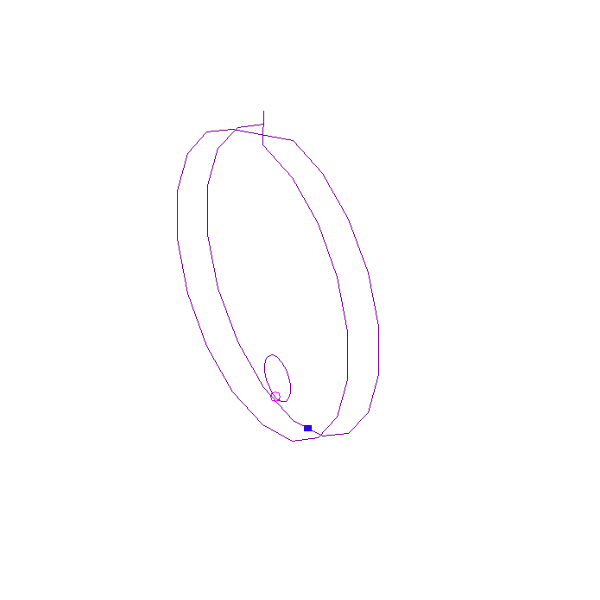Two Loop 160m Mag Antenna
I already own a small commercially made Mag loop (an Alpha - it is fine, it works ok, but it is small, and anything lower than 40m it is just out of it's comfort zone).
There is a UK ham called M0MSN who has an excellent you-tube channel, where he builds things (usually on his kitchen table).
This is what a normal loop looks like ..

Mike, a few years ago - he built a double loop. Which looks something like this...

Why double ?
The 'maths' for mag loops suggests that the size needs to be 10-20% of the wavelength - for decent effiency. You could have a 1m diameter mag loop for 160m - it would not work very well.
If you want to check this yourself please look at the online calculator provided by https://www.66pacific.com/calculators/small-transmitting-loop-antenna-calculator.aspx.
So an efficient circumferance for 160m is between 19.7 and 39.3 meters at the specified frequency of 1.85 MHz.
Single Loop Effiency
Circumferance
- 20m
- 27% efficient
- 25m
- 42% efficient
- 30m
- 56% efficient
- 35m
- 66% efficient
- 39m
- 73% efficient
So bigger is better - but 39m Circumferance has a radium of 6.2m - so it would stand 12.4m tall !! This would be too difficult to support.
Two Loops - means smaller
It seems easy to suggest that therefore having two loops but with the same overall length(circumferance) should yield the same results ...
I tried to model this - but my NEC Primatives are not great when dealing with arcs and spirals.... So I resorted to programming.
I wrote a Double loop nec generator.
This is the code
from math import sin,cos from pprint import pprint DR=0.3 # Driven Radius DR_EXTRA=0.333 # Raise Driven a little more R=2. # Radius W=2.54*.825/100 #In Meters SEG=1 ANGLE=20 # Steps in each circle LOOPS=2 # How many concentric loops DIST=0.3 #Cm between Loops LIFT=5.0 # How much it is raised wires=[] driven=[] cross_pos=-1 for l in range(0,LOOPS): for a in range(0,360,ANGLE): b=(a/360.0)*2.0*3.1415 #Radians x=sin(b)*R y=cos(b)*R d=l*DIST wires.append([x,d,y+LIFT]) x=sin(b)*DR y=cos(b)*DR if (l==0): driven.append([x,DIST/2.0,y+LIFT-R+DR+DR_EXTRA]) if l==1: cross_pos = len(wires) print(f"CE Need to jump from wire {cross_pos} to {cross_pos+1}") print(f"CE We do this by going verticlly up a small gap.") print(f"CE In practice this could be more smooth") tag=1 print("CM Double Loop build from Python") print("CM") print("""CE CE SY C=184.5434pf""") for w in range(0,len(wires)-1): print(f"GW {tag:4d}\t{SEG:4d}\t{wires[w][0]:5.4}\t{wires[w][1]:5.4}\t{wires[w][2]:5.4}\t{wires[w+1][0]:5.4}\t{wires[w+1][1]:5.4}\t{wires[w+1][2]:5.4}\t{W}") tag=tag+1 w=0 tag=100 e=len(wires)-1 print(f"GW {tag:4d} {SEG:4d} {wires[e][0]:5.4} {wires[e][1]:5.4} {wires[e][2]:5.4} {wires[e][0]:5.4} {wires[e][1]:5.4} {wires[e][2]+0.2:5.4} {W}") tag +=1 print(f"GW {tag:4d} {SEG:4d} {wires[w][0]:5.4} {wires[w][1]:5.4} {wires[w][2]:5.4} {wires[e][0]:5.4} {wires[e][1]:5.4} {wires[e][2]+0.2:5.4} {W}") tag=200 for w in range(0,len(driven)-1): print(f"GW {tag:4d} {SEG:4d} {driven[w][0]:5.4} {driven[w][1]:5.4} {driven[w][2]:5.4} {driven[w+1][0]:5.4} {driven[w+1][1]:5.4} {driven[w+1][2]:5.4} {W}") tag=tag+1 w+=1 print(f"GW {tag:4d} {SEG:4d} {driven[w][0]:5.4} {driven[w][1]:5.4} {driven[w][2]:5.4} {driven[0][0]:5.4} {driven[0][1]:5.4} {driven[0][2]:5.4} {W}") print("""GE 1 LD 0 27 1 1 0 0 C GN 2 0 0 0 4 0.003 EK EX 6 209 1 0 1 0 0 0 CE SET Freq to be a little up from bottom - so we can see how sharp this is FR 0 0 0 0 1.84 0 EN""")
To run this - you need Python3 - which is usually installed on most machines these days.
To generate the NEC File you issue this command
python loop.py > 2L.nec
This will create a 2L.nec file - which you open using 4NEC2.
Analysing the NEC file
The model should build with only segment warnings from the driven loop - I do not know how to remove these. They are already 1 segment long.

Nice SWR, and great looking effiency.
The far field plot looks good also - not the lowest angles.

I then did a frequency sweep from 1.78Mhz. - through to 1.9Mhz

You will notice the VERY VERY sharp dip. This will be a blessing and a curse.
This will require re-tuning almost every time you move even the smallest frequency step. This will need to be automated (arduino Steppir anyone ?)
Parts list
- 25m of 7/8" Hard Heliax (Main Loop)
- 1.88m of LMR400 for driven Loop (Heliax will not bend this small)
- Some supports for the Heliax
- 184pF Variable Capacitor